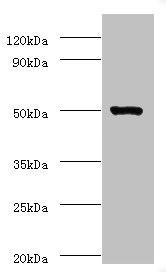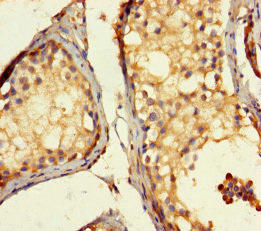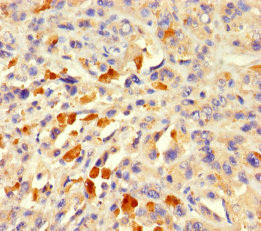Description
| Antibody Name: | ACTL7A Antibody (PACO42698) |
| Antibody SKU: | PACO42698 |
| Size: | 50ug |
| Host Species: | Rabbit |
| Tested Applications: | ELISA, WB, IHC |
| Recommended Dilutions: | ELISA:1:2000-1:10000, WB:1:1000-1:5000, IHC:1:20-1:200 |
| Species Reactivity: | Human, Mouse |
| Immunogen: | Recombinant Human Actin-like protein 7A protein (1-435AA) |
| Form: | Liquid |
| Storage Buffer: | Preservative: 0.03% Proclin 300 Constituents: 50% Glycerol, 0.01M PBS, PH 7.4 |
| Purification Method: | >95%, Protein G purified |
| Clonality: | Polyclonal |
| Isotype: | IgG |
| Conjugate: | Non-conjugated |
 | Western blot. All lanes: ACTL7A antibody at 2µg/ml + Mouse liver tissue. Secondary. Goat polyclonal to rabbit IgG at 1/10000 dilution. Predicted band size: 49 kDa. Observed band size: 49 kDa. |
 | Immunohistochemistry of paraffin-embedded human testis tissue using PACO42698 at dilution of 1:100. |
 | Immunohistochemistry of paraffin-embedded human melanoma using PACO42698 at dilution of 1:100. |
| Background: | Interacts (via N-terminus) with TES (via LIM domain 2). Heterodimer with TES; the heterodimer interacts with ENAH to form a heterotrimer. |
| Synonyms: | Actin-like protein 7A (Actin-like-7-alpha), ACTL7A |
| UniProt Protein Function: | AL7A: an actin-related protein (ARP). Shares significant amino acid sequence identity to conventional actins. Both actins and ARPs have an actin fold, which is an ATP-binding cleft, as a common feature. The ARPs are involved in diverse cellular processes, including vesicular transport, spindle orientation, nuclear migration and chromatin remodeling. Its gene (ACTL7A), and a related gene, ACTL7B, are intronless. Expressed in a wide variety of adult tissues, however, its exact function is not known.Protein type: Motility/polarity/chemotaxis; CytoskeletalChromosomal Location of Human Ortholog: 9q31Cellular Component: male germ cell nucleus; Golgi apparatus; protein complex; cytoskeleton; cytoplasm; nucleusMolecular Function: structural constituent of cytoskeleton |
| UniProt Protein Details: | |
| NCBI Summary: | The protein encoded by this gene is a member of a family of actin-related proteins (ARPs) which share significant amino acid sequence identity to conventional actins. Both actins and ARPs have an actin fold, which is an ATP-binding cleft, as a common feature. The ARPs are involved in diverse cellular processes, including vesicular transport, spindle orientation, nuclear migration and chromatin remodeling. This gene (ACTL7A), and related gene, ACTL7B, are intronless, and are located approximately 4 kb apart in a head-to-head orientation within the familial dysautonomia candidate region on 9q31. Based on mutational analysis of the ACTL7A gene in patients with this disorder, it was concluded that it is unlikely to be involved in the pathogenesis of dysautonomia. The ACTL7A gene is expressed in a wide variety of adult tissues, however, its exact function is not known. [provided by RefSeq, Jul 2008] |
| UniProt Code: | Q9Y615 |
| NCBI GenInfo Identifier: | 5729720 |
| NCBI Gene ID: | 10881 |
| NCBI Accession: | NP_006678.1 |
| UniProt Secondary Accession: | Q9Y615,Q5JSV0, B2RC83 |
| UniProt Related Accession: | Q9Y615 |
| Molecular Weight: | 48,644 Da |
| NCBI Full Name: | actin-like protein 7A |
| NCBI Synonym Full Names: | actin-like 7A |
| NCBI Official Symbol: | ACTL7A |
| NCBI Official Synonym Symbols: | |
| NCBI Protein Information: | actin-like protein 7A; actin-like 7-alpha; actin-like-7-alpha |
| UniProt Protein Name: | Actin-like protein 7A |
| UniProt Synonym Protein Names: | Actin-like-7-alpha |
| Protein Family: | |
| UniProt Gene Name: | ACTL7A |
| UniProt Entry Name: | ACL7A_HUMAN |
| Antibodies |
| ACTL7A Antibody (PACO07582) |
| Secondary Antibody |
| Anti-HRP Goat Anti-Rabbit IgG (H+L) Antibody (CABS014) |
| Recommended Products |
| Anti-FITC Goat Anti-Rabbit IgG (H+L) Antibody (CABS011) |
| Anti-HRP-conjugated Beta Actin Antibody (CABC028) |






